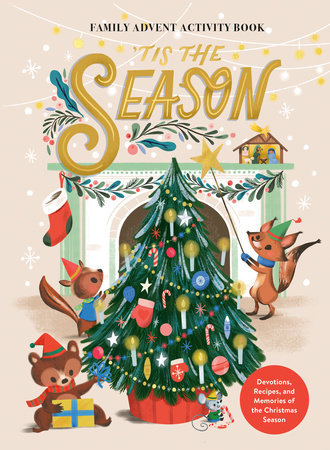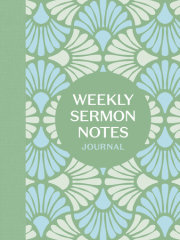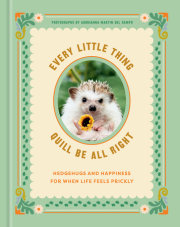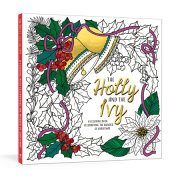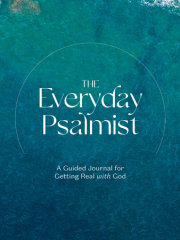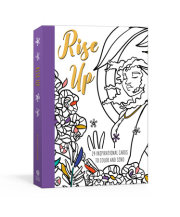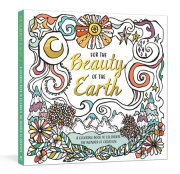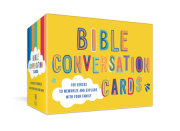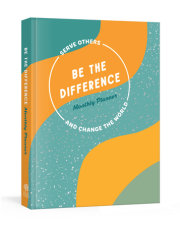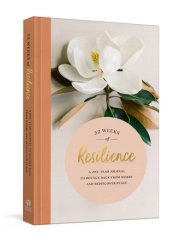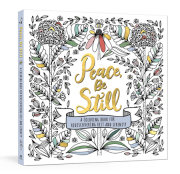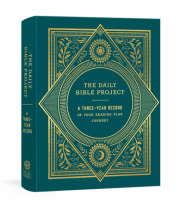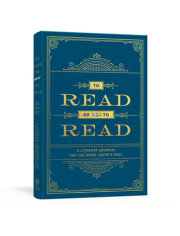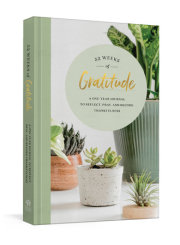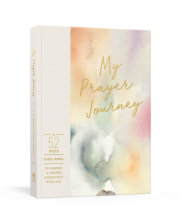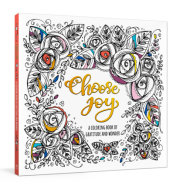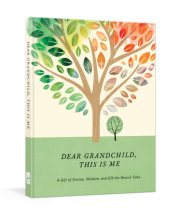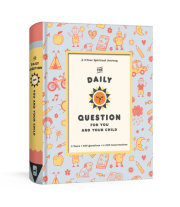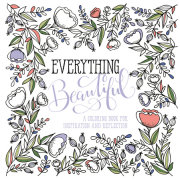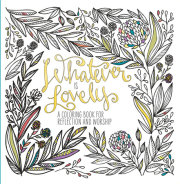Designed to follow the four weeks of Advent—Hope, Faith, Joy, and Peace—'Tis the Season Family Advent Activity Book features an Advent calendar with lift-the-flap windows that can be used year after year. Each of the four week-long sections includes a short devotion on each theme followed by reflection questions and simple action prompts for every age level. The book also contains game ideas, recipes, holiday tips, fun facts, and encouragement on how to live out the themes of Advent as an individual, with your family, and in your community.
Because this unique activity book is designed to be used year after year, you can make this book part of your annual tradition. Special features include the keepsake section at the back of the book for recording holiday memories and the special built-in, undated Advent calendar for creating and sharing Christmas cheer, with an original activity each day:
- Try a new cookie recipe
- Deliver treats to a neighbor
- Start a family tradition
- Visit someone who needs cheer
- Create a new ornament
- Learn “Merry Christmas” in a different language
As you return to this book year after year, may it bring smiles and create memories that you will cherish for many Christmases to come.
A Parent's Guide
The Lord is coming, always coming. When you have ears to hear and eyes to see, you will recognize him at any moment of your life. Life is Advent; life is recognizing the coming of the Lord. —Henri J.M. Nouwen
When we hear the word “advent” today, different images might come to mind—from candles on decorative wreaths to calendars concealing chocolates to the overall season of Christmas itself. Despite its history, however, the majority of believers in the Christian tradition mostly define Advent as the four-week (or forty-day) preparation period leading up to December 25, the date chosen by most church calendars as the day to recognize and celebrate the birth and incarnation of Jesus. While that may be part of what Advent is, it’s not quite the full story.
The word advent is derived from the Latin adventus and the Greek parousia, which both signify a “coming.” In the time of the early church, the practice of Advent began in a response to Jesus’s command: “Therefore keep watch, because you do not know on what day your Lord will come” (Matthew 24:42). So the origin of Advent is less about Jesus coming to earth as a baby and more about preparing ourselves for his second coming.
As we read in the book of Acts, this “anticipation” began immediately after Jesus ascended to heaven. The disciples, staring upward and no doubt experiencing a range of emotions from confusion and sorrow to wonder and amazement, were confronted by two angelic beings, who asked, “Why do you stand here looking into the sky? This same Jesus, who has been taken from you into heaven, will come back in the same way you have seen him go into heaven” (Acts 1:11).
Today, Christians around the world still wait year-round in eager expectation for Jesus’s return. Even so, since the Middle Ages, the actual season of Advent has become more connected to his first coming as a baby in Bethlehem. In the “new” definition, Advent references a time that extends from the end of November to December 25 and is specially marked by the four Sundays in between.
The themes for each of these Sundays vary slightly in different church traditions, but the most common are Hope, Faith, Joy, and Peace. Many churches mark each of these four Sundays by lighting a new candle in a wreath every week during the service. The actual origins of the wreath and candle tradition are a bit unclear since candles have long been symbols of hope and expectation through seasons of darkness. However, there is a story of a German Lutheran pastor in 1839 decorating a cart’s wheel with an evergreen wreath and candles to provide a visual aid of counting down the days until Christmas for the children in his mission school. The evergreen, which remains a vibrant green even through the long and dark winter months, acts as a representation of God’s unconditional love and his promise of eternal life. Red holly berries, which are often intertwined into the wreath, symbolize Jesus’s blood and the crown of thorns. Depending on the country or the specific church tradition, between one and twenty-four candles may be lit during the four weeks leading up to Christmas. The most common tradition involves four candles—with one being lit each Sunday—and a fifth candle in the center marking Christmas Day and the celebration of Jesus’s birth.
Though we may all have different ways of recognizing Jesus’s first coming and anticipating his second, we as the people of God are all united in the practice of hope and expectation. In fact, it’s a tradition that extends back almost to the Garden of Eden. Of course, the specific ways we observe this waiting have changed a lot over time.
Your church or family might have their own unique traditions during this season, and that is part of the beauty of Advent. However your family celebrates Advent, may you all experience a greater feeling of connection to one another as you draw nearer to Christ, reflect together on the importance of the season, create new traditions, and record memories throughout the many Christmases to come.
About
Designed to follow the four weeks of Advent—Hope, Faith, Joy, and Peace—'Tis the Season Family Advent Activity Book features an Advent calendar with lift-the-flap windows that can be used year after year. Each of the four week-long sections includes a short devotion on each theme followed by reflection questions and simple action prompts for every age level. The book also contains game ideas, recipes, holiday tips, fun facts, and encouragement on how to live out the themes of Advent as an individual, with your family, and in your community.
Because this unique activity book is designed to be used year after year, you can make this book part of your annual tradition. Special features include the keepsake section at the back of the book for recording holiday memories and the special built-in, undated Advent calendar for creating and sharing Christmas cheer, with an original activity each day:
- Try a new cookie recipe
- Deliver treats to a neighbor
- Start a family tradition
- Visit someone who needs cheer
- Create a new ornament
- Learn “Merry Christmas” in a different language
As you return to this book year after year, may it bring smiles and create memories that you will cherish for many Christmases to come.
Author
Excerpt
A Parent's Guide
The Lord is coming, always coming. When you have ears to hear and eyes to see, you will recognize him at any moment of your life. Life is Advent; life is recognizing the coming of the Lord. —Henri J.M. Nouwen
When we hear the word “advent” today, different images might come to mind—from candles on decorative wreaths to calendars concealing chocolates to the overall season of Christmas itself. Despite its history, however, the majority of believers in the Christian tradition mostly define Advent as the four-week (or forty-day) preparation period leading up to December 25, the date chosen by most church calendars as the day to recognize and celebrate the birth and incarnation of Jesus. While that may be part of what Advent is, it’s not quite the full story.
The word advent is derived from the Latin adventus and the Greek parousia, which both signify a “coming.” In the time of the early church, the practice of Advent began in a response to Jesus’s command: “Therefore keep watch, because you do not know on what day your Lord will come” (Matthew 24:42). So the origin of Advent is less about Jesus coming to earth as a baby and more about preparing ourselves for his second coming.
As we read in the book of Acts, this “anticipation” began immediately after Jesus ascended to heaven. The disciples, staring upward and no doubt experiencing a range of emotions from confusion and sorrow to wonder and amazement, were confronted by two angelic beings, who asked, “Why do you stand here looking into the sky? This same Jesus, who has been taken from you into heaven, will come back in the same way you have seen him go into heaven” (Acts 1:11).
Today, Christians around the world still wait year-round in eager expectation for Jesus’s return. Even so, since the Middle Ages, the actual season of Advent has become more connected to his first coming as a baby in Bethlehem. In the “new” definition, Advent references a time that extends from the end of November to December 25 and is specially marked by the four Sundays in between.
The themes for each of these Sundays vary slightly in different church traditions, but the most common are Hope, Faith, Joy, and Peace. Many churches mark each of these four Sundays by lighting a new candle in a wreath every week during the service. The actual origins of the wreath and candle tradition are a bit unclear since candles have long been symbols of hope and expectation through seasons of darkness. However, there is a story of a German Lutheran pastor in 1839 decorating a cart’s wheel with an evergreen wreath and candles to provide a visual aid of counting down the days until Christmas for the children in his mission school. The evergreen, which remains a vibrant green even through the long and dark winter months, acts as a representation of God’s unconditional love and his promise of eternal life. Red holly berries, which are often intertwined into the wreath, symbolize Jesus’s blood and the crown of thorns. Depending on the country or the specific church tradition, between one and twenty-four candles may be lit during the four weeks leading up to Christmas. The most common tradition involves four candles—with one being lit each Sunday—and a fifth candle in the center marking Christmas Day and the celebration of Jesus’s birth.
Though we may all have different ways of recognizing Jesus’s first coming and anticipating his second, we as the people of God are all united in the practice of hope and expectation. In fact, it’s a tradition that extends back almost to the Garden of Eden. Of course, the specific ways we observe this waiting have changed a lot over time.
Your church or family might have their own unique traditions during this season, and that is part of the beauty of Advent. However your family celebrates Advent, may you all experience a greater feeling of connection to one another as you draw nearer to Christ, reflect together on the importance of the season, create new traditions, and record memories throughout the many Christmases to come.
Notifications






